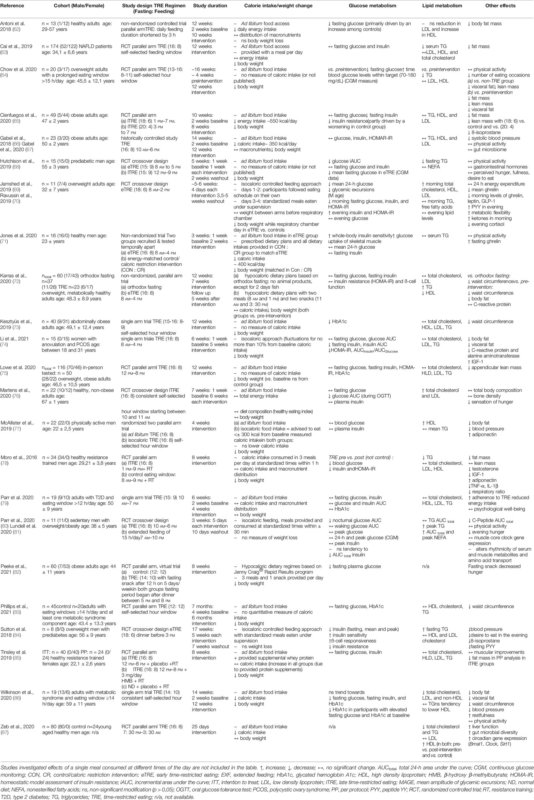What is Time Restricted Eating?
Time-restricted eating is a form of “Intermittent fasting” which could be called daily intermittent fasting. It is pretty simple, just stop eating for at least 12 hours…everyday, usually overnight (and then eat at other times of day). It has a long history, human did not have continuous access to a food supply and evolved fasting customs such as “Sustenance” in China and Ramadan for Muslims.
The question I want to answer is: is it really better than simple dieting alone (ie are there benefits beyond caloric restriction)?
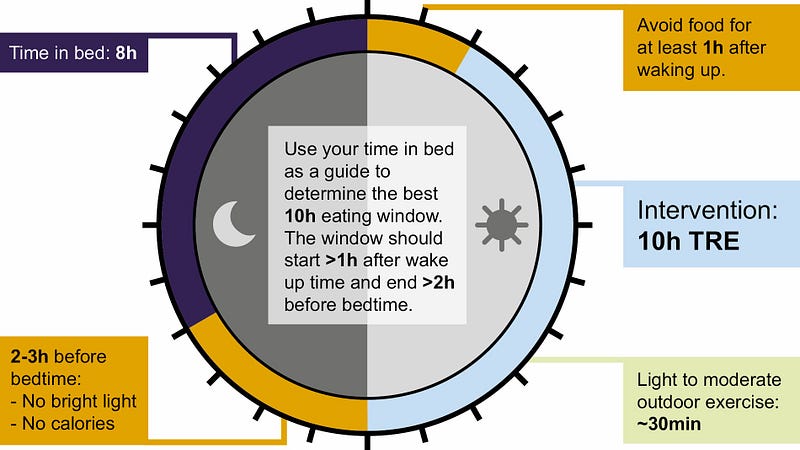
What is the Point of TRE?
If you eat three times a day (see figure), you spend most of the day (and night) in an anabolic (ie fed) state; insulin is low but glucagon and growth hormone, are elevated. This signals your body to halt any fat burning, to store excess calories in your fat cells, and burn glucose (from your last meal) instead. Over time this leads to insulin resistance.

EATING THREE TIMES PER DAY FIGURE
After the first few hours after a meal your body goes into a post–absorptive state, and then after 8 to 12 hours after your last meal a catabolic (or fasted state). This is shown in the shaded red area. If you eat only twice a day, or better once a day, then your hormonal state will adapt to this fasted state by returning insulin to normal.

EATING TWICE PER DAY FIGURE
By eating once per day your average insulin level is much lower, although it will spike following your meal, this is normal to control glucose. You spend more time in a fasted state.
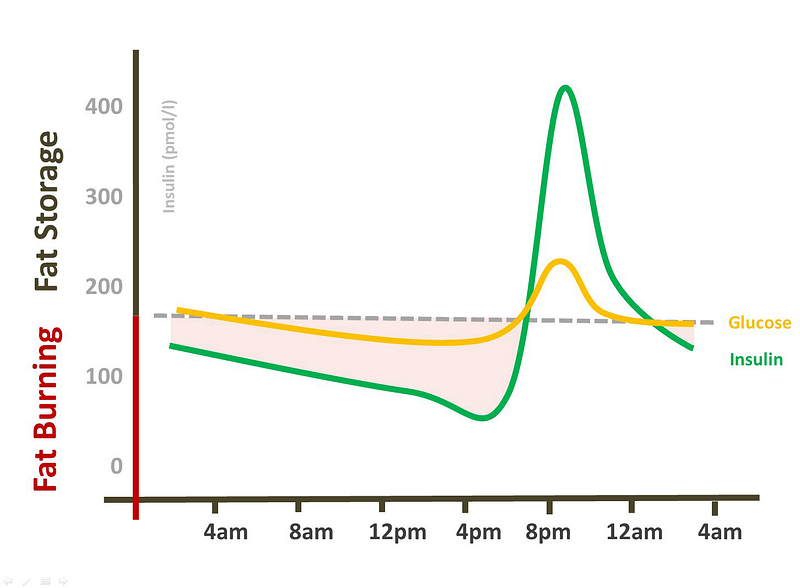
EATING ONCE PER DAY FIGURE
Circadian Effects
Circadian rhythms are thought to be largely controlled by light and the brain but there are new discoveries of molecular clocks in individual organs. At the molecular level, the circadian clock is based on cell-autonomous feedback circuit driven by the basic helix–loop–helix-PER-ARNT-SIM (bHLH-PAS) transcription factors BMAL1 (no I have no idea what that means either 😂)
What is important is that the circadian clock is present in almost all tissues and cells. And there is a potentially important circadian rhythm in insulin release such that it is higher during the first half of the day. At night, the rise in melatonin before bedtime can inhibit glucose-induced insulin release from the pancreatic β cells. Hence, consuming a bigger portion of daily caloric intake in the first half of wakeful hours may be preferred for better blood glucose regulation, body weight control, and related health outcomes.
Further food resets the circadian rhythm. For example animals (? and some people!) will wake up a few hours before the arrival of food and start moving anticipating food. Such food-anticipatory activity would also occur when calories are reduced and presented at night and the magnitude of activity would increase with the reduction in calories.
When Should I Fast and When Should I Eat?
According to conventional wisdom, the exact hours don’t matter, so you could do
12hr fast 12hr eating: normal IF method
16hr fast 8hr eating: Leangains method (by Martin Berkhan)
20hr fast 4hr eating: Warrior Diet method (by Ori Hofmekler)
But this is a simplification. The longer the fast, the more benefit you get. Also new research (see below suggesting timing might matter after all).
In all these methods, you avoid eating later at night or early in the morning (usually skipping breakfast)….but wait….doesn’t this breaks all those old-wives tales of eating:
“Breakfast is the most important meal of the day!”
“Eat small frequent meals.”
“Your metabolism slows down when you are fasting.”
“If I don’t eat I will get low blood sugar [hypoglycemia].”
Correct, but this is science. A huge new review has just examined all the animal and human data.

They examined 39 human studies ranging from 4 days to 1 year.
The most common finding was a decrease in body weight and to a lesser extent improved glucose regulation (decreased fasting glucose and glucose area under the curve assessed via continuous glucose monitoring, improved insulin sensitivity, and increased β-cell function) was observed in 12 studies and additional benefits to cardiovascular health eg decreases in blood pressure.
Does the Time of Day of Fasting Matter?
There is a huge naturalistic experiment on this; Ramadan. Ramadan, is daylight/daytime fasting for the the ninth month in the Islamic calendar, which is observed worldwide by Muslims. A study that compared TRE with Ramadan fasting found that the 2 fasting strategies had similar characteristics and positive health effects (31).
Early morning is likely to be an optimal TRE time to induce maximal metabolic benefits. In most early TRE studies, restricting food intake to the morning resulted in an improvement of insulin sensitivity, beta-cell responsiveness, blood pressure, inflammation, and oxidative stress. In contrast, on late TRE, restricting food intake to the late afternoon or evening (after 4 PM) did not change or even worsen blood glucose, beta-cell responsiveness, and lipid levels. BUT I only found two direct comparison studies
2019 study and this new 2022 study!
In the first, a cross-over design where postprandial glucose and fasting triglycerides decreased after consuming both diets, whereas mean fasting glucose assessed by CGM improved only with early TRE.
In the second, authors compared early TRE (food intake restricted to the early part of the day) and mid-day TRe (food intake restricted to the middle of the day) versus no TRE in three groups of 30.
Early TRe was more effective than mTRF at improving insulin sensitivity. Furthermore, eTRF, but not mTRF, improved fasting glucose, reduced total body mass and adiposity, ameliorated inflammation, and increased gut microbial diversity. The authors think this may be due to circadian rhythms as eTRF influenced the daily rhythms of ghrelin and resistin.
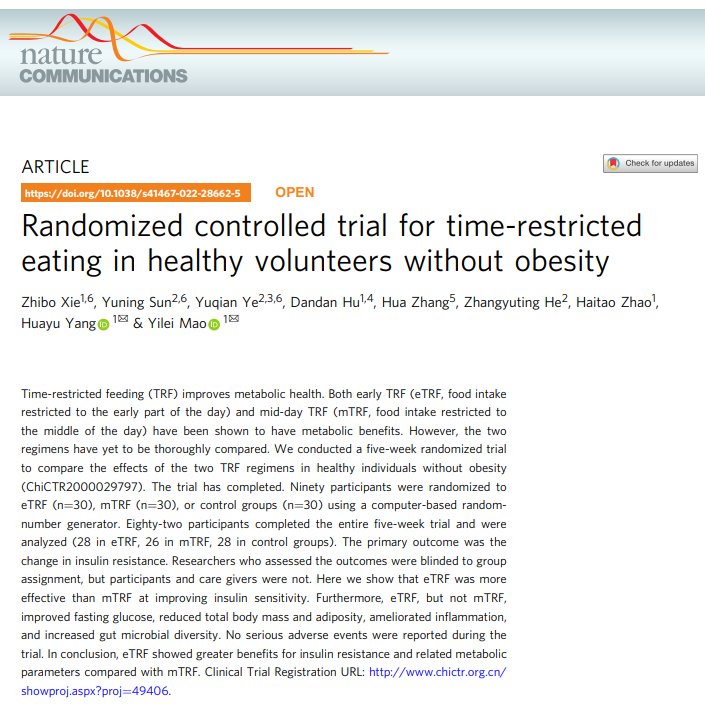
No Magic Bullet?
So all this evidence means it works right? True. You can see the studies in this pop-up image:
But here comes the catch…..isn’t this just the same as calorie restriction by any method??
In other words, can you do intermittent fasting and not restrict your diet at all…and it still works? If so, then yes it would be like a magic bullet. One study has compared intermittent fasting with a normal timed but structured diet of similar calories and found no difference (see link) . TRE typically reduces caloric consumption by approximately 20% despite the ability to consume food and drink “ad libitum” (aka unrestricted) during the eating window each day. So is TRE a form of caloric reduction is similar to diets with intentional daily caloric restriction (CR)…..or is it something special?
I found four TRE trials where the beneficial effects on the glucose metabolism seemed to beindependentt caloric restriction or weight loss:
Antoni R, Robertson T, Robertson M, Johnston J. A Pilot Feasibility Study Exploring the Effects of a Moderate Time-Restricted Feeding Intervention on Energy Intake, Adiposity and Metabolic Physiology in Free-Living Human Subjects. J Nutr Sci (2018) 7:e22. doi: 10.1017/jns.2018.13
Jamshed H, Beyl RA, Della Manna DL, Yang ES, Ravussin E, Peterson CM. Early Time-Restricted Feeding Improves 24-Hour Glucose Levels and Affects Markers of the Circadian Clock, Aging, and Autophagy in Humans. Nutrients (2019) 11:1234. doi: 10.3390/nu11061234
Martens CR, Rossman MJ, Mazzo MR, Jankowski LR, Nagy EE, Denman BA, et al. Short-Term Time-Restricted Feeding Is Safe and Feasible in Non-Obese Healthy Midlife and Older Adults. Geroscience (2020) 42:667–86. doi: 10.1007/s11357-020-00156-6
Sutton EF, Beyl R, Early KS, Cefalu WT, Ravussin E, Peterson CM. Early Time-Restricted Feeding Improves Insulin Sensitivity, Blood Pressure, and Oxidative Stress Even Without Weight Loss in Men With Prediabetes. Cell Metab (2018) 27:1212–21.e1213. doi: 10.1016/j.cmet.2018.04.010
What we need is one of two new types of study:
Intermittent fasting vs Normal Fasting (with the same calories)
Intermittent fasting vs usual diet (but with the same calories)
and in fact I found two such studies.
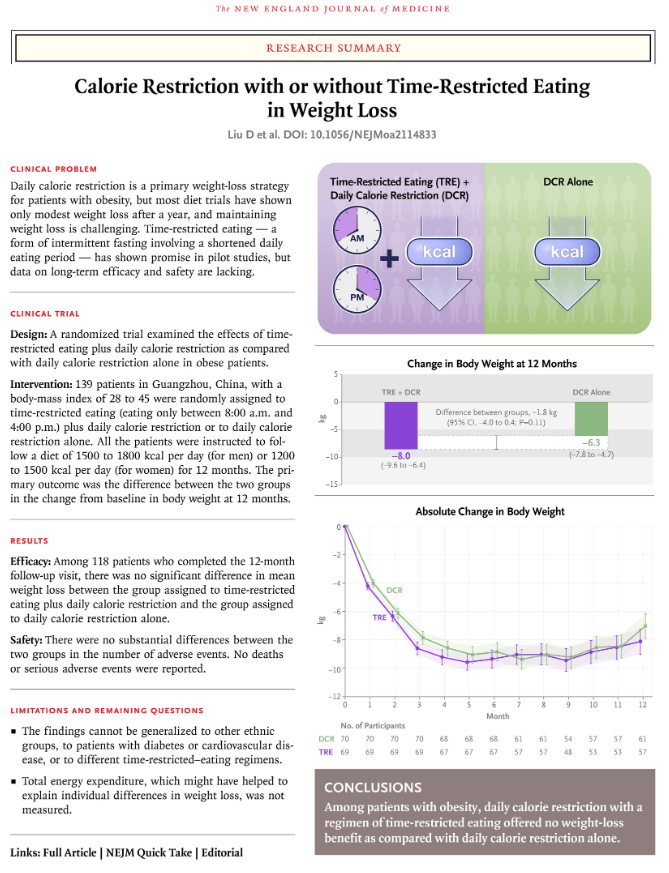
Liu et al. conducted an RCT of calorie restriction alone as compared with calorie restriction plus time-restricted eating in weight loss in 139 patients with obesity. All the patients were assigned a diet that represented a 25% calorie reduction from baseline to be followed for 12 months.
The trial tested whether 8-hour time-restricted eating plus calorie restriction was superior to calorie restriction alone.
The percent weight loss from baseline to 12 months was 9.0% (8.0 kg) in the time-restriction group but almost as good: 7.2% (6.3 kg) in the calorie-restriction-only group. Waist circumference, body-mass index, body fat, blood pressure, and biomarker levels decreased significantly over the trial time period with no differences.
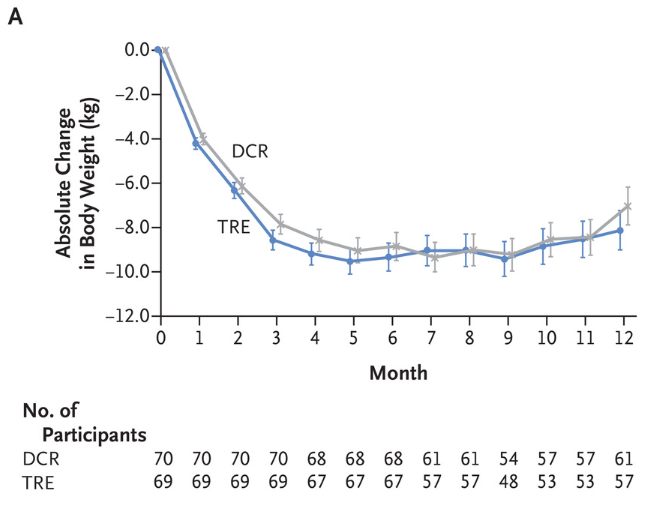
These results of the trial suggest that time-restricted eating is roughly the same as calorie restriction however time-restricted all said, time-restricted eating seemed simpler, because caloric restriction needed intensive coaching and monitoring but time-restricted eating did not.
————————————————————————————————————–
The second study is in preprint / prerelease
Jamshed et al, Effectiveness of Early Time-Restricted Eating for Weight Loss, Fat Loss, and Cardiometabolic Health
in Adults With Obesity, JAMA Internal Medicine (2022). DOI: 10.1001/jamainternmed.2022.3050
This study extended the LIU findings by fasting an extra 4.8 hours per day vs only a modest 2.3-hour change in the Liu et al study.
In this randomized clinical trial, eTRE was more effective for losing weight and improving diastolic blood pressure and mood than eating over a window of 12 or more hours but both groups were helped to maintain a calorie deficit of 500kcal. The eTRE group lost an additional 2.3 kg relative to the control group, an approximately 50% improvement in weight loss.
The authors report the magnitude of the weight-loss effect we observed was equivalent to reducing energy intake by an additional 214 kcal/d and is in line with 2 recent meta-analyses reporting that TRE has modest to moderate effects on body weight. Though we could not trace this energy deficit to changes in physical activity or food intake, we suspect that eTRE did reduce energy intake, but we were unable to detect it owing to the well-known limitations of accurately assessing food intake via self-report.
Another way to say this is that TRE had an additional “magic bullet” effect of around 200kcal/per day.
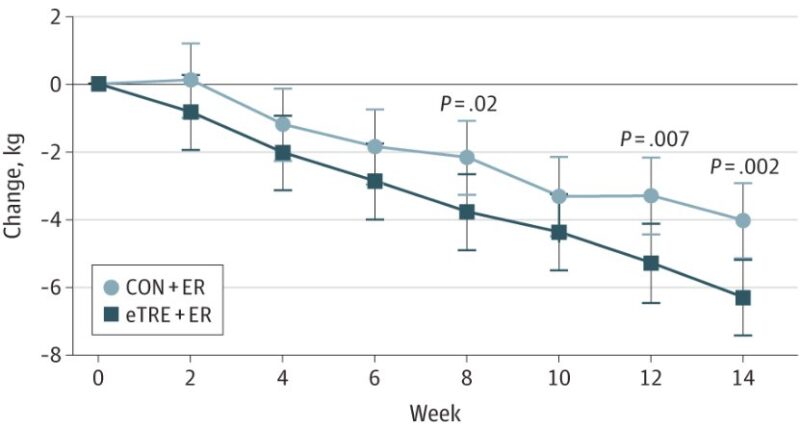
Calorie Controlled Animal Studies
Whilst we wait for more human studies, there are some hints from animal studies where calories were held constant but timing was varied. Irrespective of the time of day when the calorie restricted diet was given to mice consistently, in the morning, afternoon, or evening, calorie restricted led to an extended lifespan. In a short-term calorie restricted study, however, calorie restricted mice receiving food in the morning (during their circadian sleep time), experienced less weight loss than mice that received the same calories at night. These TRF rodents that consume the same calories as an ad libitum cohort from the same food source exhibit improved molecular rhythms in circadian clock components and are largely protected from high-fat diet-induced obesity and related metabolic illnesses.
Conclusion
Intermittent fasting is an effective way of reducing calories and gaining weight loss and additional health benefits.
It has newly discovered benefits in terms of circadian rhythm.
However, it is *not yet* proven more effective than a rigorous calorie restriction diet by any other method
That said, if intermittent fasting works for you, then it is likely a good choice to lose weight and stay healthier.
Citations
Time Restricted Eating: A Dietary Strategy to Prevent and Treat Metabolic Disturbances
Time-restricted Eating for the Prevention and Management of Metabolic Diseases. Emily N C Manoogian, Lisa S Chow, Pam R Taub, Blandine Laferrère, Satchidananda Panda. Endocrine Reviews, Volume 43, Issue 2, April 2022, Pages 405–436 (LINK)
https://pubmed.ncbi.nlm.nih.gov/35443112/
Testing
Click Brave test1
Click Brave test 2
Testing 01-09-22



